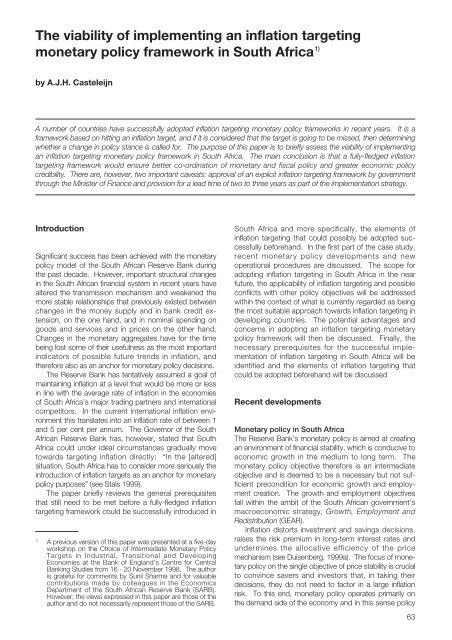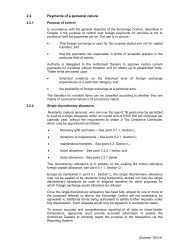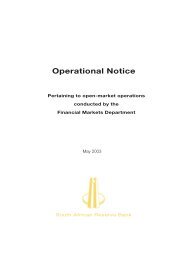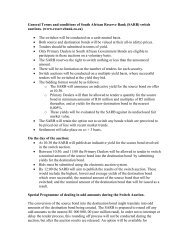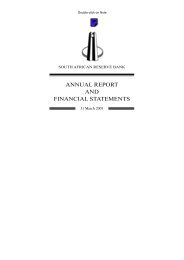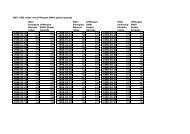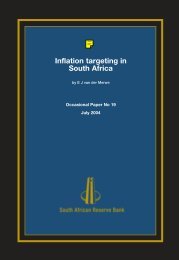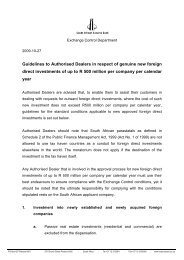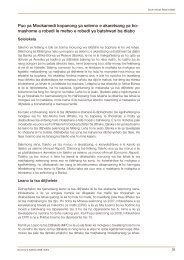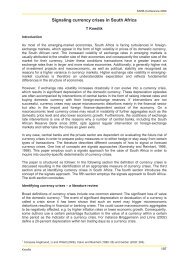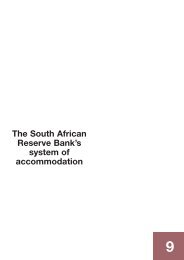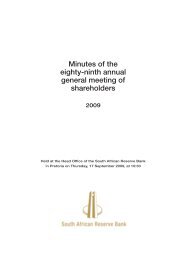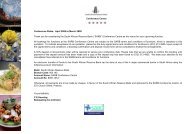Article: Quarterly Bulletin - South African Reserve Bank
Article: Quarterly Bulletin - South African Reserve Bank
Article: Quarterly Bulletin - South African Reserve Bank
Create successful ePaper yourself
Turn your PDF publications into a flip-book with our unique Google optimized e-Paper software.
The viability of implementing an inflation targeting<br />
monetary policy framework in <strong>South</strong> Africa 1)<br />
by A.J.H. Casteleijn<br />
A number of countries have successfully adopted inflation targeting monetary policy frameworks in recent years. It is a<br />
framework based on hitting an inflation target, and if it is considered that the target is going to be missed, then determining<br />
whether a change in policy stance is called for. The purpose of this paper is to briefly assess the viability of implementing<br />
an inflation targeting monetary policy framework in <strong>South</strong> Africa. The main conclusion is that a fully-fledged inflation<br />
targeting framework would ensure better co-ordination of monetary and fiscal policy and greater economic policy<br />
credibility. There are, however, two important caveats: approval of an explicit inflation targeting framework by government<br />
through the Minister of Finance and provision for a lead time of two to three years as part of the implementation strategy.<br />
Introduction<br />
Significant success has been achieved with the monetary<br />
policy model of the <strong>South</strong> <strong>African</strong> <strong>Reserve</strong> <strong>Bank</strong> during<br />
the past decade. However, important structural changes<br />
in the <strong>South</strong> <strong>African</strong> financial system in recent years have<br />
altered the transmission mechanism and weakened the<br />
more stable relationships that previously existed between<br />
changes in the money supply and in bank credit extension,<br />
on the one hand, and in nominal spending on<br />
goods and services and in prices on the other hand.<br />
Changes in the monetary aggregates have for the time<br />
being lost some of their usefulness as the most important<br />
indicators of possible future trends in inflation, and<br />
therefore also as an anchor for monetary policy decisions.<br />
The <strong>Reserve</strong> <strong>Bank</strong> has tentatively assumed a goal of<br />
maintaining inflation at a level that would be more or less<br />
in line with the average rate of inflation in the economies<br />
of <strong>South</strong> Africa’s major trading partners and international<br />
competitors. In the current international inflation environment<br />
this translates into an inflation rate of between 1<br />
and 5 per cent per annum. The Governor of the <strong>South</strong><br />
<strong>African</strong> <strong>Reserve</strong> <strong>Bank</strong> has, however, stated that <strong>South</strong><br />
Africa could under ideal circumstances gradually move<br />
towards targeting inflation directly: “In the [altered]<br />
situation, <strong>South</strong> Africa has to consider more seriously the<br />
introduction of inflation targets as an anchor for monetary<br />
policy purposes” (see Stals 1999).<br />
The paper briefly reviews the general prerequisites<br />
that still need to be met before a fully-fledged inflation<br />
targeting framework could be successfully introduced in<br />
1)<br />
A previous version of this paper was presented at a five-day<br />
workshop on the Choice of Intermediate Monetary Policy<br />
Targets in Industrial, Transitional and Developing<br />
Economies at the <strong>Bank</strong> of England’s Centre for Central<br />
<strong>Bank</strong>ing Studies from 16 - 20 November 1998. The author<br />
is grateful for comments by Sunil Sharma and for valuable<br />
contributions made by colleagues in the Economics<br />
Department of the <strong>South</strong> <strong>African</strong> <strong>Reserve</strong> <strong>Bank</strong> (SARB).<br />
However, the views expressed in this paper are those of the<br />
author and do not necessarily represent those of the SARB.<br />
<strong>South</strong> Africa and more specifically, the elements of<br />
inflation targeting that could possibly be adopted successfully<br />
beforehand. In the first part of the case study,<br />
recent monetary policy developments and new<br />
operational procedures are discussed. The scope for<br />
adopting inflation targeting in <strong>South</strong> Africa in the near<br />
future, the applicability of inflation targeting and possible<br />
conflicts with other policy objectives will be addressed<br />
within the context of what is currently regarded as being<br />
the most suitable approach towards inflation targeting in<br />
developing countries. The potential advantages and<br />
concerns in adopting an inflation targeting monetary<br />
policy framework will then be discussed. Finally, the<br />
necessary prerequisites for the successful implementation<br />
of inflation targeting in <strong>South</strong> Africa will be<br />
identified and the elements of inflation targeting that<br />
could be adopted beforehand will be discussed<br />
Recent developments<br />
Monetary policy in <strong>South</strong> Africa<br />
The <strong>Reserve</strong> <strong>Bank</strong>’s monetary policy is aimed at creating<br />
an environment of financial stability, which is conducive to<br />
economic growth in the medium to long term. The<br />
monetary policy objective therefore is an intermediate<br />
objective and is deemed to be a necessary but not sufficient<br />
precondition for economic growth and employment<br />
creation. The growth and employment objectives<br />
fall within the ambit of the <strong>South</strong> <strong>African</strong> government’s<br />
macroeconomic strategy, Growth, Employment and<br />
Redistribution (GEAR).<br />
Inflation distorts investment and savings decisions,<br />
raises the risk premium in long-term interest rates and<br />
undermines the allocative efficiency of the price<br />
mechanism (see Duisenberg, 1999a). The focus of monetary<br />
policy on the single objective of price stability is crucial<br />
to convince savers and investors that, in taking their<br />
decisions, they do not need to factor in a large inflation<br />
risk. To this end, monetary policy operates primarily on<br />
the demand side of the economy and in this sense policy<br />
63


